A Report on Change Management Strategies at Etihad Airways
VerifiedAdded on 2022/11/14
|13
|4235
|190
Report
AI Summary
This report provides a comprehensive analysis of change management strategies implemented by Etihad Airways. It begins with an overview of the airline, its market position, and the challenges it faced, including issues related to customer satisfaction, financial difficulties, and competition. The report then delves into a literature review, examining the organizational structure, key individuals responsible for managing change, and the micro and macro environmental factors influencing the company. It highlights the drivers for change, such as financial investments, customer dissatisfaction, and competition. Furthermore, the report explores the organizational restructuring strategy and process adopted by Etihad Airways, including financial, portfolio, and organizational restructuring. It discusses the methodologies used, such as planned versus unplanned change, and identifies limitations encountered during the restructuring process. The report concludes with recommendations for future change management initiatives and emphasizes the importance of adapting to the dynamic environment of the airline industry. The report also discusses the organizational design model including strategy, structure, processes, leadership, and system.
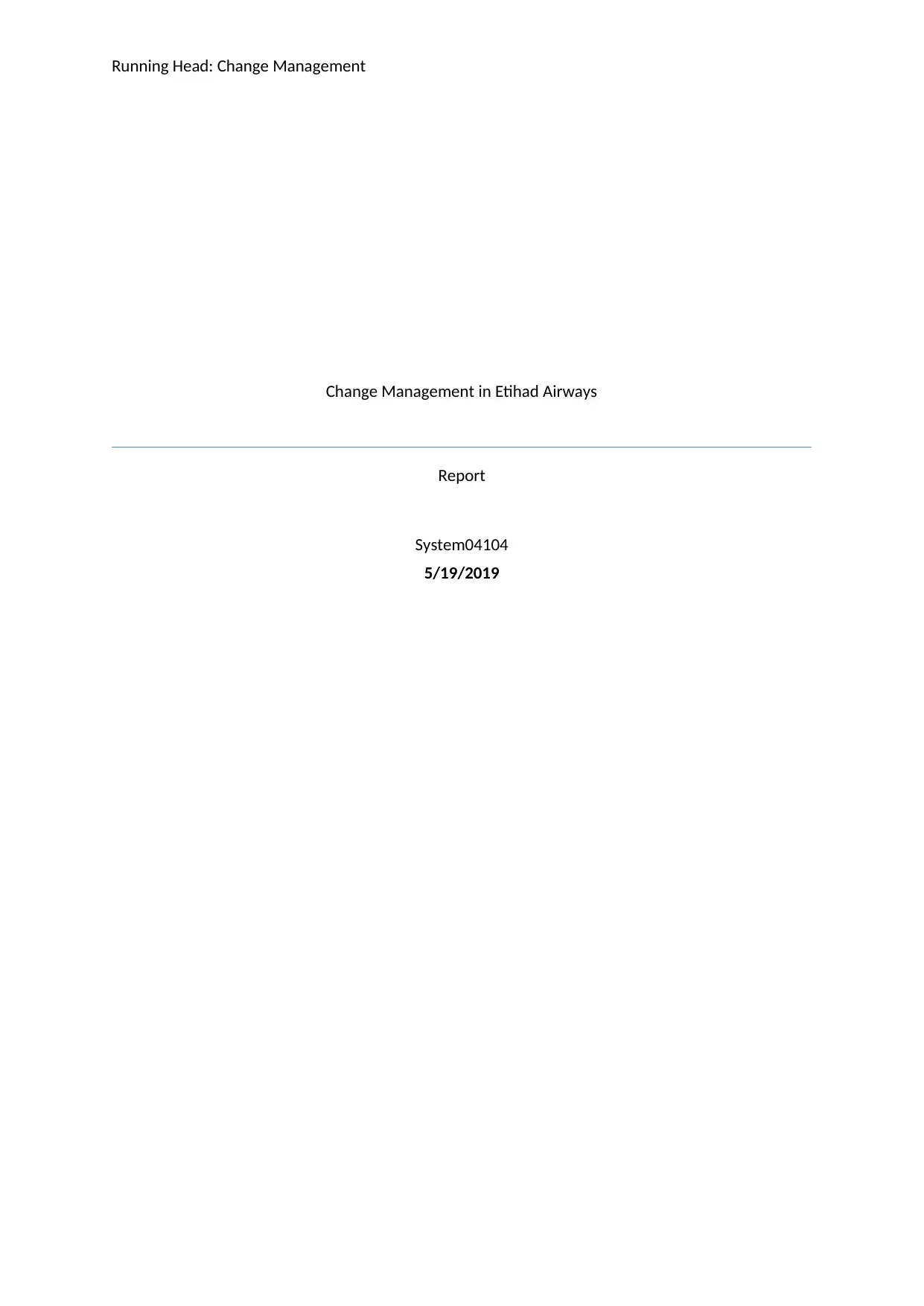
Running Head: Change Management
Change Management in Etihad Airways
Report
System04104
5/19/2019
Change Management in Etihad Airways
Report
System04104
5/19/2019
Paraphrase This Document
Need a fresh take? Get an instant paraphrase of this document with our AI Paraphraser
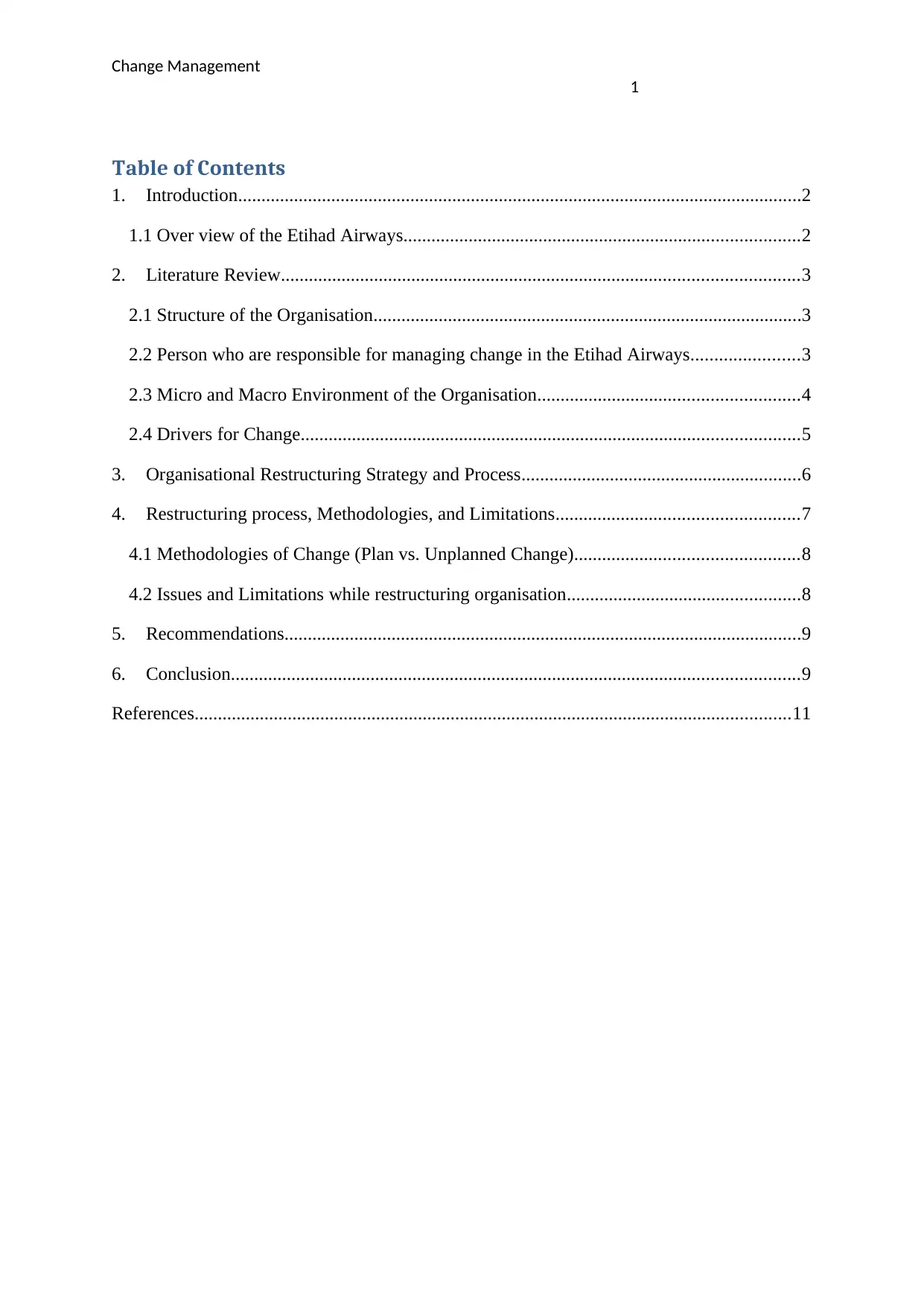
Change Management
1
Table of Contents
1. Introduction.........................................................................................................................2
1.1 Over view of the Etihad Airways.....................................................................................2
2. Literature Review...............................................................................................................3
2.1 Structure of the Organisation............................................................................................3
2.2 Person who are responsible for managing change in the Etihad Airways.......................3
2.3 Micro and Macro Environment of the Organisation........................................................4
2.4 Drivers for Change...........................................................................................................5
3. Organisational Restructuring Strategy and Process............................................................6
4. Restructuring process, Methodologies, and Limitations....................................................7
4.1 Methodologies of Change (Plan vs. Unplanned Change)................................................8
4.2 Issues and Limitations while restructuring organisation..................................................8
5. Recommendations...............................................................................................................9
6. Conclusion..........................................................................................................................9
References................................................................................................................................11
1
Table of Contents
1. Introduction.........................................................................................................................2
1.1 Over view of the Etihad Airways.....................................................................................2
2. Literature Review...............................................................................................................3
2.1 Structure of the Organisation............................................................................................3
2.2 Person who are responsible for managing change in the Etihad Airways.......................3
2.3 Micro and Macro Environment of the Organisation........................................................4
2.4 Drivers for Change...........................................................................................................5
3. Organisational Restructuring Strategy and Process............................................................6
4. Restructuring process, Methodologies, and Limitations....................................................7
4.1 Methodologies of Change (Plan vs. Unplanned Change)................................................8
4.2 Issues and Limitations while restructuring organisation..................................................8
5. Recommendations...............................................................................................................9
6. Conclusion..........................................................................................................................9
References................................................................................................................................11
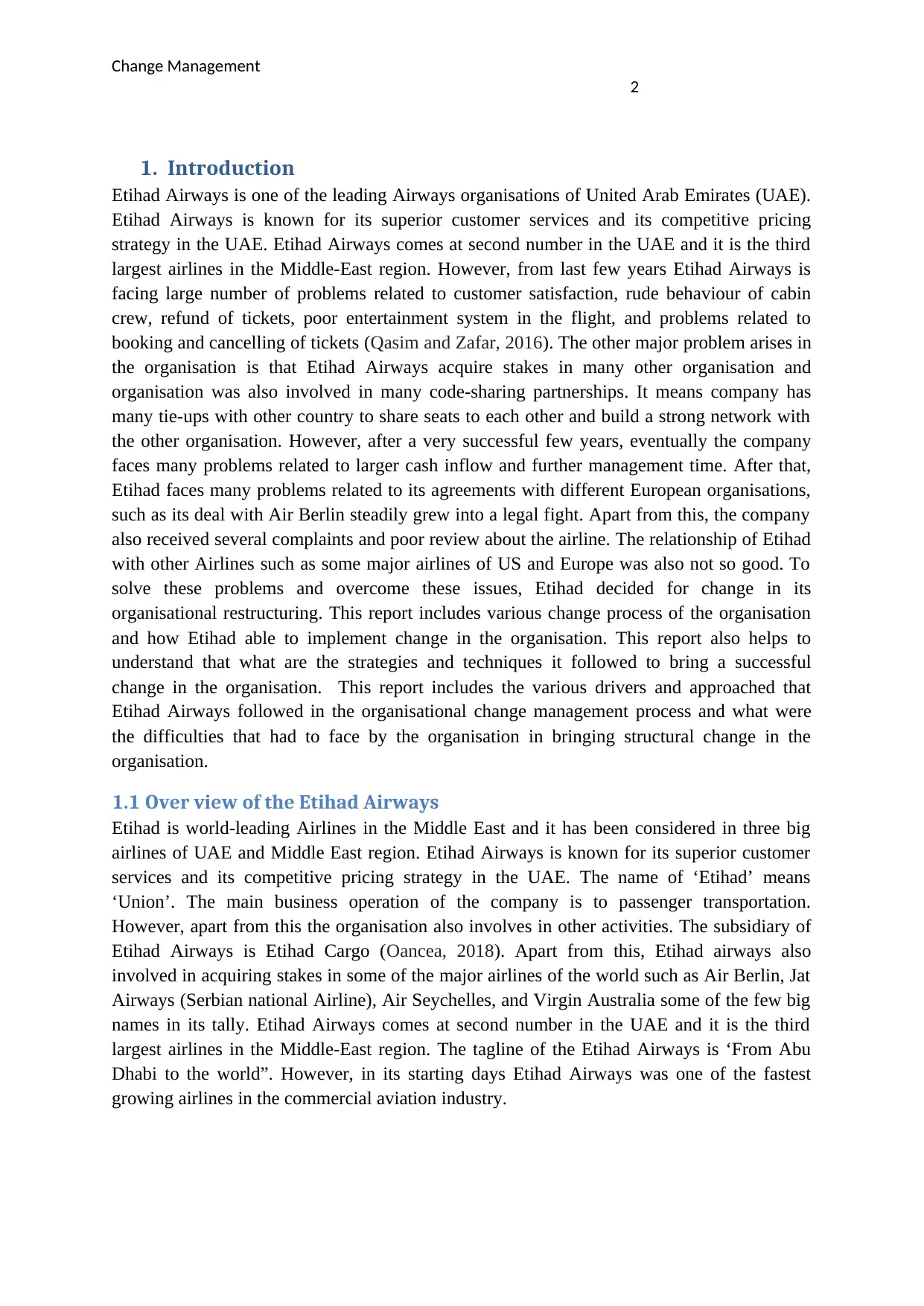
Change Management
2
1. Introduction
Etihad Airways is one of the leading Airways organisations of United Arab Emirates (UAE).
Etihad Airways is known for its superior customer services and its competitive pricing
strategy in the UAE. Etihad Airways comes at second number in the UAE and it is the third
largest airlines in the Middle-East region. However, from last few years Etihad Airways is
facing large number of problems related to customer satisfaction, rude behaviour of cabin
crew, refund of tickets, poor entertainment system in the flight, and problems related to
booking and cancelling of tickets (Qasim and Zafar, 2016). The other major problem arises in
the organisation is that Etihad Airways acquire stakes in many other organisation and
organisation was also involved in many code-sharing partnerships. It means company has
many tie-ups with other country to share seats to each other and build a strong network with
the other organisation. However, after a very successful few years, eventually the company
faces many problems related to larger cash inflow and further management time. After that,
Etihad faces many problems related to its agreements with different European organisations,
such as its deal with Air Berlin steadily grew into a legal fight. Apart from this, the company
also received several complaints and poor review about the airline. The relationship of Etihad
with other Airlines such as some major airlines of US and Europe was also not so good. To
solve these problems and overcome these issues, Etihad decided for change in its
organisational restructuring. This report includes various change process of the organisation
and how Etihad able to implement change in the organisation. This report also helps to
understand that what are the strategies and techniques it followed to bring a successful
change in the organisation. This report includes the various drivers and approached that
Etihad Airways followed in the organisational change management process and what were
the difficulties that had to face by the organisation in bringing structural change in the
organisation.
1.1 Over view of the Etihad Airways
Etihad is world-leading Airlines in the Middle East and it has been considered in three big
airlines of UAE and Middle East region. Etihad Airways is known for its superior customer
services and its competitive pricing strategy in the UAE. The name of ‘Etihad’ means
‘Union’. The main business operation of the company is to passenger transportation.
However, apart from this the organisation also involves in other activities. The subsidiary of
Etihad Airways is Etihad Cargo (Oancea, 2018). Apart from this, Etihad airways also
involved in acquiring stakes in some of the major airlines of the world such as Air Berlin, Jat
Airways (Serbian national Airline), Air Seychelles, and Virgin Australia some of the few big
names in its tally. Etihad Airways comes at second number in the UAE and it is the third
largest airlines in the Middle-East region. The tagline of the Etihad Airways is ‘From Abu
Dhabi to the world”. However, in its starting days Etihad Airways was one of the fastest
growing airlines in the commercial aviation industry.
2
1. Introduction
Etihad Airways is one of the leading Airways organisations of United Arab Emirates (UAE).
Etihad Airways is known for its superior customer services and its competitive pricing
strategy in the UAE. Etihad Airways comes at second number in the UAE and it is the third
largest airlines in the Middle-East region. However, from last few years Etihad Airways is
facing large number of problems related to customer satisfaction, rude behaviour of cabin
crew, refund of tickets, poor entertainment system in the flight, and problems related to
booking and cancelling of tickets (Qasim and Zafar, 2016). The other major problem arises in
the organisation is that Etihad Airways acquire stakes in many other organisation and
organisation was also involved in many code-sharing partnerships. It means company has
many tie-ups with other country to share seats to each other and build a strong network with
the other organisation. However, after a very successful few years, eventually the company
faces many problems related to larger cash inflow and further management time. After that,
Etihad faces many problems related to its agreements with different European organisations,
such as its deal with Air Berlin steadily grew into a legal fight. Apart from this, the company
also received several complaints and poor review about the airline. The relationship of Etihad
with other Airlines such as some major airlines of US and Europe was also not so good. To
solve these problems and overcome these issues, Etihad decided for change in its
organisational restructuring. This report includes various change process of the organisation
and how Etihad able to implement change in the organisation. This report also helps to
understand that what are the strategies and techniques it followed to bring a successful
change in the organisation. This report includes the various drivers and approached that
Etihad Airways followed in the organisational change management process and what were
the difficulties that had to face by the organisation in bringing structural change in the
organisation.
1.1 Over view of the Etihad Airways
Etihad is world-leading Airlines in the Middle East and it has been considered in three big
airlines of UAE and Middle East region. Etihad Airways is known for its superior customer
services and its competitive pricing strategy in the UAE. The name of ‘Etihad’ means
‘Union’. The main business operation of the company is to passenger transportation.
However, apart from this the organisation also involves in other activities. The subsidiary of
Etihad Airways is Etihad Cargo (Oancea, 2018). Apart from this, Etihad airways also
involved in acquiring stakes in some of the major airlines of the world such as Air Berlin, Jat
Airways (Serbian national Airline), Air Seychelles, and Virgin Australia some of the few big
names in its tally. Etihad Airways comes at second number in the UAE and it is the third
largest airlines in the Middle-East region. The tagline of the Etihad Airways is ‘From Abu
Dhabi to the world”. However, in its starting days Etihad Airways was one of the fastest
growing airlines in the commercial aviation industry.
⊘ This is a preview!⊘
Do you want full access?
Subscribe today to unlock all pages.

Trusted by 1+ million students worldwide
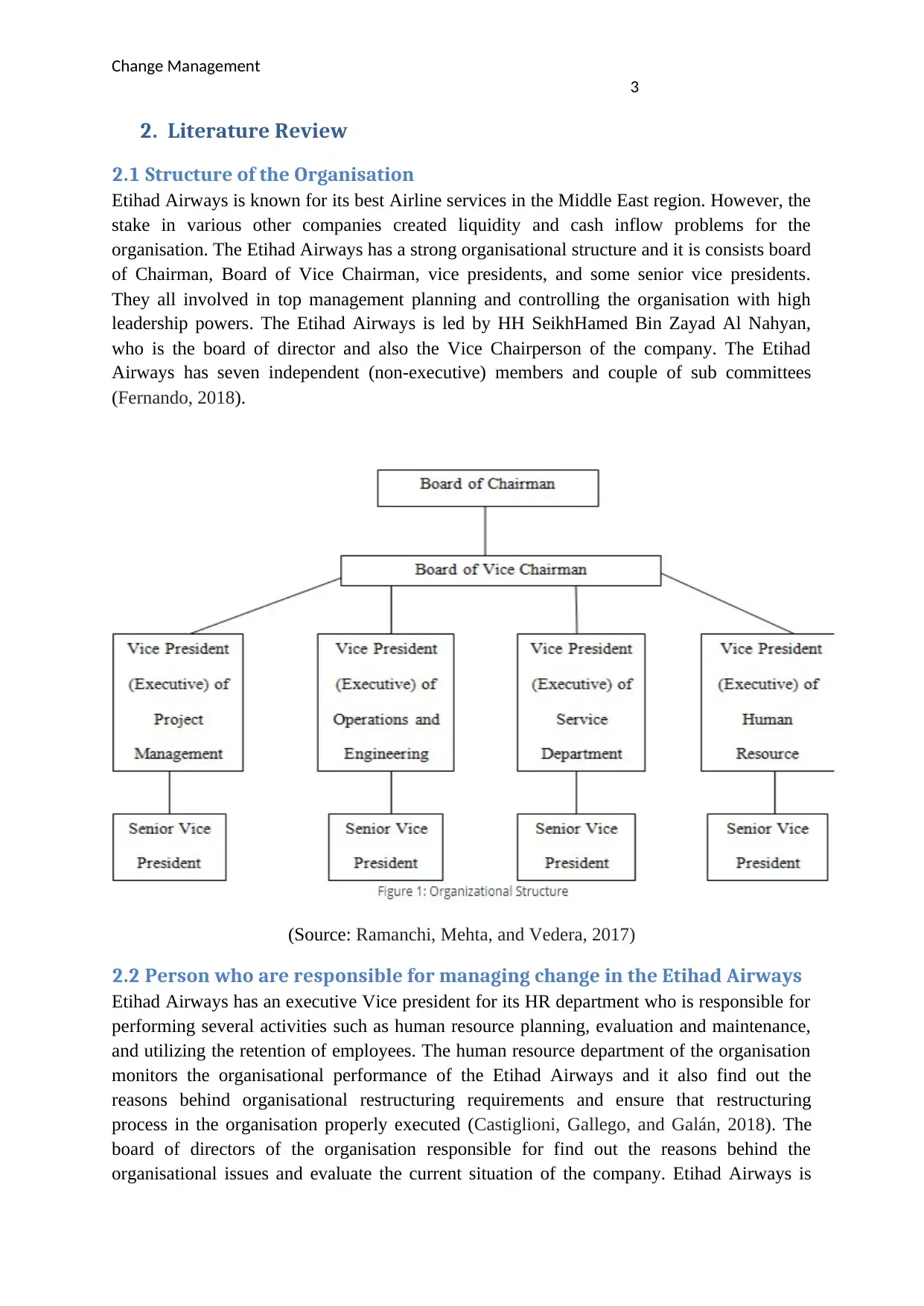
Change Management
3
2. Literature Review
2.1 Structure of the Organisation
Etihad Airways is known for its best Airline services in the Middle East region. However, the
stake in various other companies created liquidity and cash inflow problems for the
organisation. The Etihad Airways has a strong organisational structure and it is consists board
of Chairman, Board of Vice Chairman, vice presidents, and some senior vice presidents.
They all involved in top management planning and controlling the organisation with high
leadership powers. The Etihad Airways is led by HH SeikhHamed Bin Zayad Al Nahyan,
who is the board of director and also the Vice Chairperson of the company. The Etihad
Airways has seven independent (non-executive) members and couple of sub committees
(Fernando, 2018).
(Source: Ramanchi, Mehta, and Vedera, 2017)
2.2 Person who are responsible for managing change in the Etihad Airways
Etihad Airways has an executive Vice president for its HR department who is responsible for
performing several activities such as human resource planning, evaluation and maintenance,
and utilizing the retention of employees. The human resource department of the organisation
monitors the organisational performance of the Etihad Airways and it also find out the
reasons behind organisational restructuring requirements and ensure that restructuring
process in the organisation properly executed (Castiglioni, Gallego, and Galán, 2018). The
board of directors of the organisation responsible for find out the reasons behind the
organisational issues and evaluate the current situation of the company. Etihad Airways is
3
2. Literature Review
2.1 Structure of the Organisation
Etihad Airways is known for its best Airline services in the Middle East region. However, the
stake in various other companies created liquidity and cash inflow problems for the
organisation. The Etihad Airways has a strong organisational structure and it is consists board
of Chairman, Board of Vice Chairman, vice presidents, and some senior vice presidents.
They all involved in top management planning and controlling the organisation with high
leadership powers. The Etihad Airways is led by HH SeikhHamed Bin Zayad Al Nahyan,
who is the board of director and also the Vice Chairperson of the company. The Etihad
Airways has seven independent (non-executive) members and couple of sub committees
(Fernando, 2018).
(Source: Ramanchi, Mehta, and Vedera, 2017)
2.2 Person who are responsible for managing change in the Etihad Airways
Etihad Airways has an executive Vice president for its HR department who is responsible for
performing several activities such as human resource planning, evaluation and maintenance,
and utilizing the retention of employees. The human resource department of the organisation
monitors the organisational performance of the Etihad Airways and it also find out the
reasons behind organisational restructuring requirements and ensure that restructuring
process in the organisation properly executed (Castiglioni, Gallego, and Galán, 2018). The
board of directors of the organisation responsible for find out the reasons behind the
organisational issues and evaluate the current situation of the company. Etihad Airways is
Paraphrase This Document
Need a fresh take? Get an instant paraphrase of this document with our AI Paraphraser
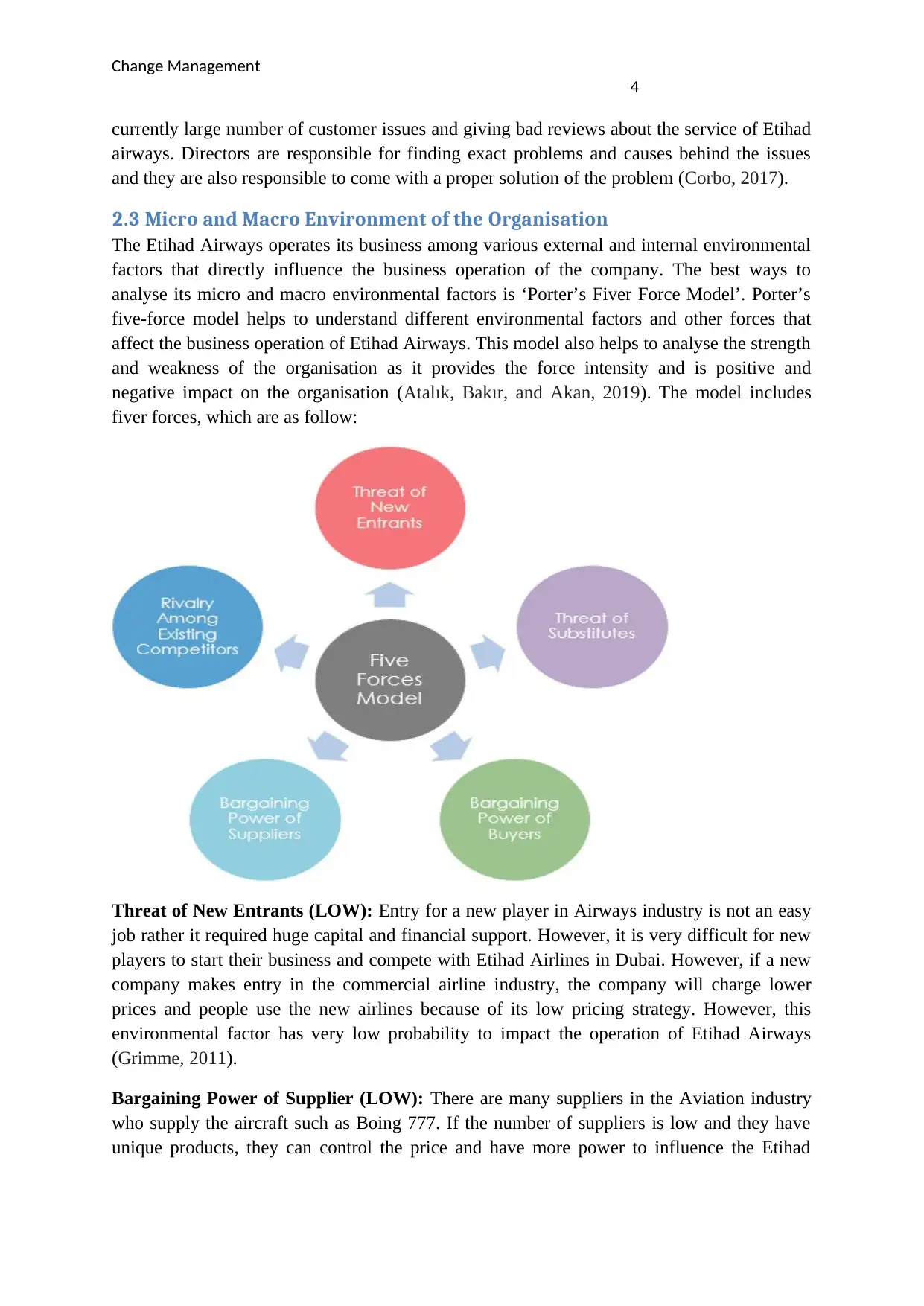
Change Management
4
currently large number of customer issues and giving bad reviews about the service of Etihad
airways. Directors are responsible for finding exact problems and causes behind the issues
and they are also responsible to come with a proper solution of the problem (Corbo, 2017).
2.3 Micro and Macro Environment of the Organisation
The Etihad Airways operates its business among various external and internal environmental
factors that directly influence the business operation of the company. The best ways to
analyse its micro and macro environmental factors is ‘Porter’s Fiver Force Model’. Porter’s
five-force model helps to understand different environmental factors and other forces that
affect the business operation of Etihad Airways. This model also helps to analyse the strength
and weakness of the organisation as it provides the force intensity and is positive and
negative impact on the organisation (Atalık, Bakır, and Akan, 2019). The model includes
fiver forces, which are as follow:
Threat of New Entrants (LOW): Entry for a new player in Airways industry is not an easy
job rather it required huge capital and financial support. However, it is very difficult for new
players to start their business and compete with Etihad Airlines in Dubai. However, if a new
company makes entry in the commercial airline industry, the company will charge lower
prices and people use the new airlines because of its low pricing strategy. However, this
environmental factor has very low probability to impact the operation of Etihad Airways
(Grimme, 2011).
Bargaining Power of Supplier (LOW): There are many suppliers in the Aviation industry
who supply the aircraft such as Boing 777. If the number of suppliers is low and they have
unique products, they can control the price and have more power to influence the Etihad
4
currently large number of customer issues and giving bad reviews about the service of Etihad
airways. Directors are responsible for finding exact problems and causes behind the issues
and they are also responsible to come with a proper solution of the problem (Corbo, 2017).
2.3 Micro and Macro Environment of the Organisation
The Etihad Airways operates its business among various external and internal environmental
factors that directly influence the business operation of the company. The best ways to
analyse its micro and macro environmental factors is ‘Porter’s Fiver Force Model’. Porter’s
five-force model helps to understand different environmental factors and other forces that
affect the business operation of Etihad Airways. This model also helps to analyse the strength
and weakness of the organisation as it provides the force intensity and is positive and
negative impact on the organisation (Atalık, Bakır, and Akan, 2019). The model includes
fiver forces, which are as follow:
Threat of New Entrants (LOW): Entry for a new player in Airways industry is not an easy
job rather it required huge capital and financial support. However, it is very difficult for new
players to start their business and compete with Etihad Airlines in Dubai. However, if a new
company makes entry in the commercial airline industry, the company will charge lower
prices and people use the new airlines because of its low pricing strategy. However, this
environmental factor has very low probability to impact the operation of Etihad Airways
(Grimme, 2011).
Bargaining Power of Supplier (LOW): There are many suppliers in the Aviation industry
who supply the aircraft such as Boing 777. If the number of suppliers is low and they have
unique products, they can control the price and have more power to influence the Etihad
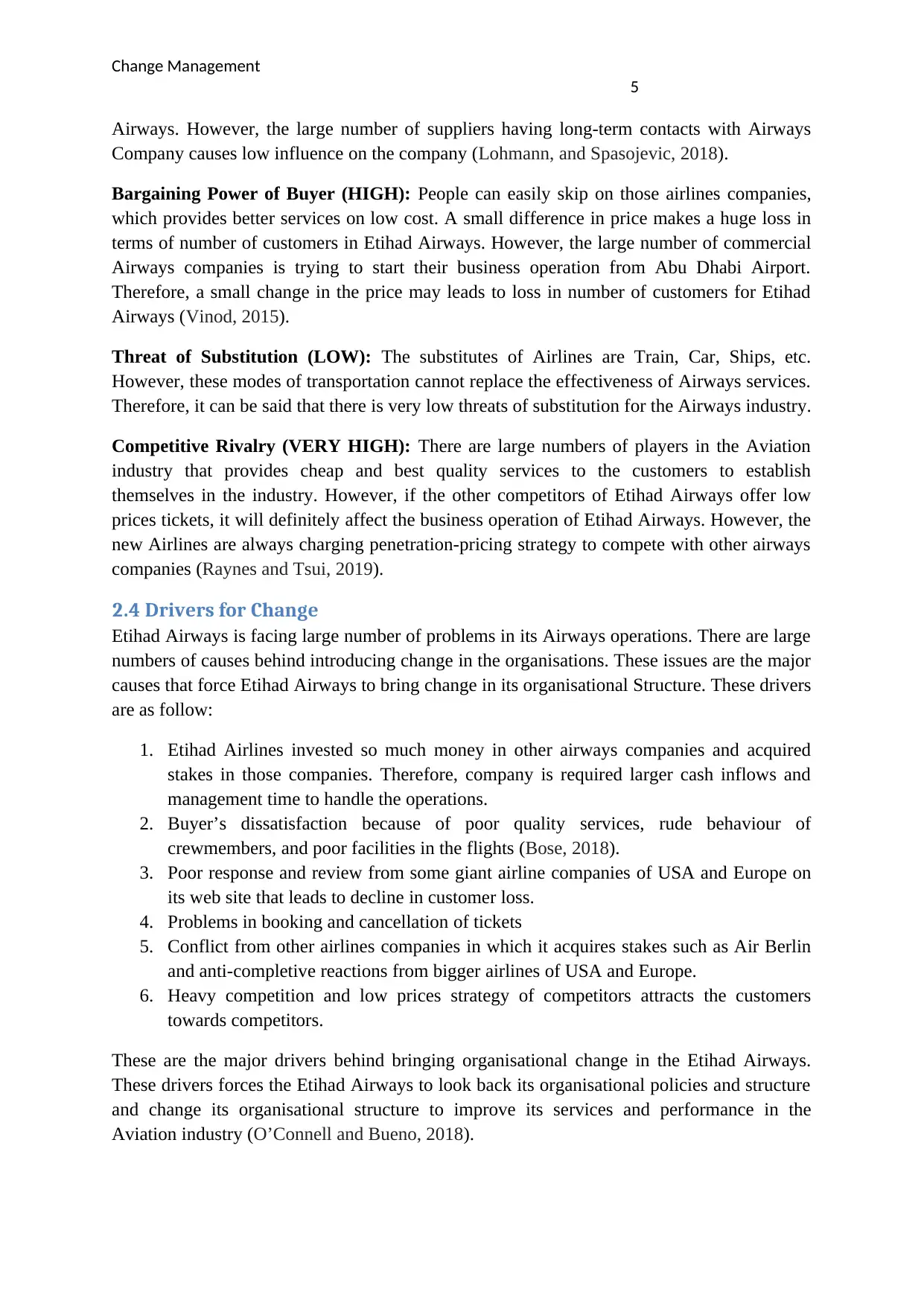
Change Management
5
Airways. However, the large number of suppliers having long-term contacts with Airways
Company causes low influence on the company (Lohmann, and Spasojevic, 2018).
Bargaining Power of Buyer (HIGH): People can easily skip on those airlines companies,
which provides better services on low cost. A small difference in price makes a huge loss in
terms of number of customers in Etihad Airways. However, the large number of commercial
Airways companies is trying to start their business operation from Abu Dhabi Airport.
Therefore, a small change in the price may leads to loss in number of customers for Etihad
Airways (Vinod, 2015).
Threat of Substitution (LOW): The substitutes of Airlines are Train, Car, Ships, etc.
However, these modes of transportation cannot replace the effectiveness of Airways services.
Therefore, it can be said that there is very low threats of substitution for the Airways industry.
Competitive Rivalry (VERY HIGH): There are large numbers of players in the Aviation
industry that provides cheap and best quality services to the customers to establish
themselves in the industry. However, if the other competitors of Etihad Airways offer low
prices tickets, it will definitely affect the business operation of Etihad Airways. However, the
new Airlines are always charging penetration-pricing strategy to compete with other airways
companies (Raynes and Tsui, 2019).
2.4 Drivers for Change
Etihad Airways is facing large number of problems in its Airways operations. There are large
numbers of causes behind introducing change in the organisations. These issues are the major
causes that force Etihad Airways to bring change in its organisational Structure. These drivers
are as follow:
1. Etihad Airlines invested so much money in other airways companies and acquired
stakes in those companies. Therefore, company is required larger cash inflows and
management time to handle the operations.
2. Buyer’s dissatisfaction because of poor quality services, rude behaviour of
crewmembers, and poor facilities in the flights (Bose, 2018).
3. Poor response and review from some giant airline companies of USA and Europe on
its web site that leads to decline in customer loss.
4. Problems in booking and cancellation of tickets
5. Conflict from other airlines companies in which it acquires stakes such as Air Berlin
and anti-completive reactions from bigger airlines of USA and Europe.
6. Heavy competition and low prices strategy of competitors attracts the customers
towards competitors.
These are the major drivers behind bringing organisational change in the Etihad Airways.
These drivers forces the Etihad Airways to look back its organisational policies and structure
and change its organisational structure to improve its services and performance in the
Aviation industry (O’Connell and Bueno, 2018).
5
Airways. However, the large number of suppliers having long-term contacts with Airways
Company causes low influence on the company (Lohmann, and Spasojevic, 2018).
Bargaining Power of Buyer (HIGH): People can easily skip on those airlines companies,
which provides better services on low cost. A small difference in price makes a huge loss in
terms of number of customers in Etihad Airways. However, the large number of commercial
Airways companies is trying to start their business operation from Abu Dhabi Airport.
Therefore, a small change in the price may leads to loss in number of customers for Etihad
Airways (Vinod, 2015).
Threat of Substitution (LOW): The substitutes of Airlines are Train, Car, Ships, etc.
However, these modes of transportation cannot replace the effectiveness of Airways services.
Therefore, it can be said that there is very low threats of substitution for the Airways industry.
Competitive Rivalry (VERY HIGH): There are large numbers of players in the Aviation
industry that provides cheap and best quality services to the customers to establish
themselves in the industry. However, if the other competitors of Etihad Airways offer low
prices tickets, it will definitely affect the business operation of Etihad Airways. However, the
new Airlines are always charging penetration-pricing strategy to compete with other airways
companies (Raynes and Tsui, 2019).
2.4 Drivers for Change
Etihad Airways is facing large number of problems in its Airways operations. There are large
numbers of causes behind introducing change in the organisations. These issues are the major
causes that force Etihad Airways to bring change in its organisational Structure. These drivers
are as follow:
1. Etihad Airlines invested so much money in other airways companies and acquired
stakes in those companies. Therefore, company is required larger cash inflows and
management time to handle the operations.
2. Buyer’s dissatisfaction because of poor quality services, rude behaviour of
crewmembers, and poor facilities in the flights (Bose, 2018).
3. Poor response and review from some giant airline companies of USA and Europe on
its web site that leads to decline in customer loss.
4. Problems in booking and cancellation of tickets
5. Conflict from other airlines companies in which it acquires stakes such as Air Berlin
and anti-completive reactions from bigger airlines of USA and Europe.
6. Heavy competition and low prices strategy of competitors attracts the customers
towards competitors.
These are the major drivers behind bringing organisational change in the Etihad Airways.
These drivers forces the Etihad Airways to look back its organisational policies and structure
and change its organisational structure to improve its services and performance in the
Aviation industry (O’Connell and Bueno, 2018).
⊘ This is a preview!⊘
Do you want full access?
Subscribe today to unlock all pages.

Trusted by 1+ million students worldwide
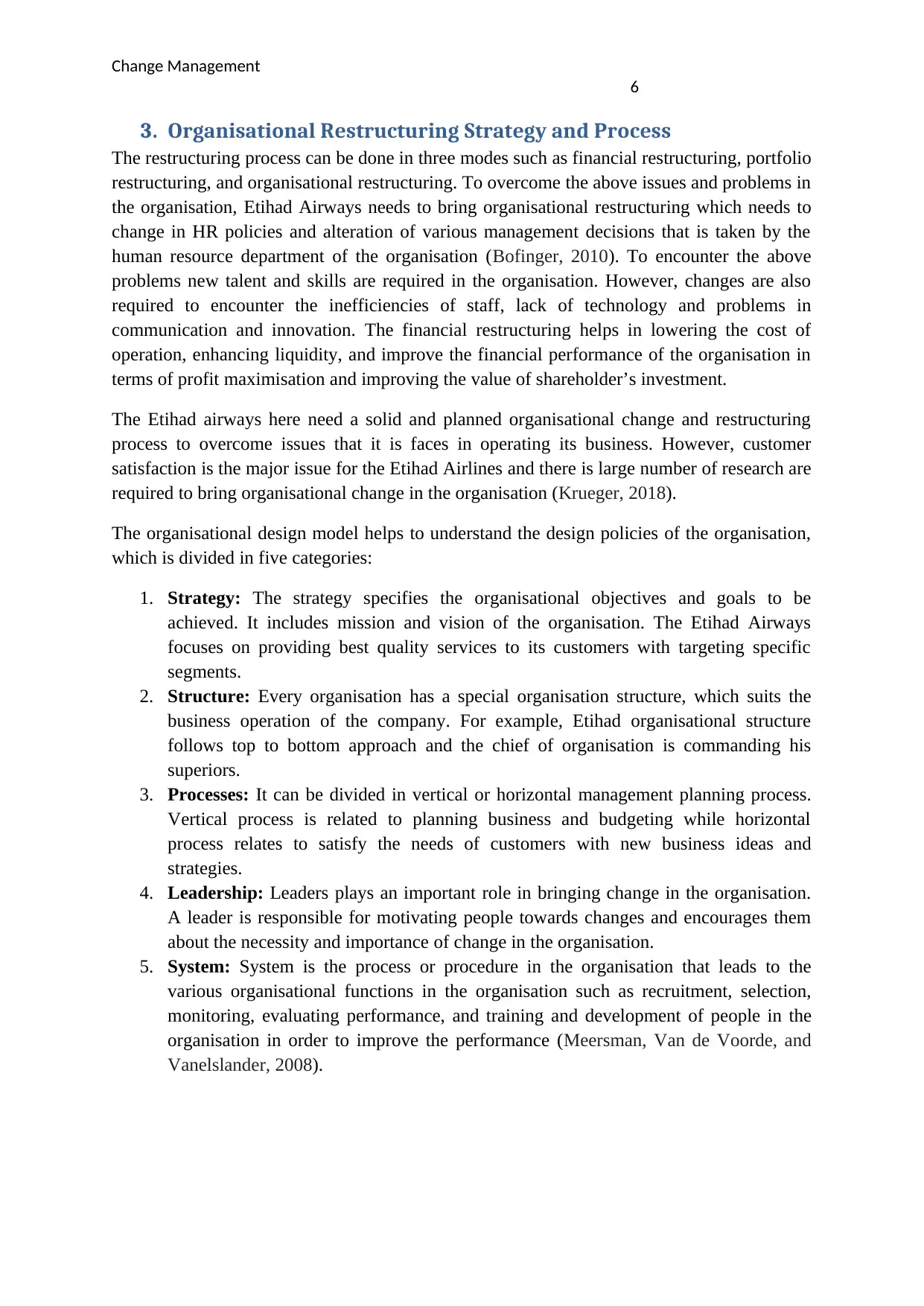
Change Management
6
3. Organisational Restructuring Strategy and Process
The restructuring process can be done in three modes such as financial restructuring, portfolio
restructuring, and organisational restructuring. To overcome the above issues and problems in
the organisation, Etihad Airways needs to bring organisational restructuring which needs to
change in HR policies and alteration of various management decisions that is taken by the
human resource department of the organisation (Bofinger, 2010). To encounter the above
problems new talent and skills are required in the organisation. However, changes are also
required to encounter the inefficiencies of staff, lack of technology and problems in
communication and innovation. The financial restructuring helps in lowering the cost of
operation, enhancing liquidity, and improve the financial performance of the organisation in
terms of profit maximisation and improving the value of shareholder’s investment.
The Etihad airways here need a solid and planned organisational change and restructuring
process to overcome issues that it is faces in operating its business. However, customer
satisfaction is the major issue for the Etihad Airlines and there is large number of research are
required to bring organisational change in the organisation (Krueger, 2018).
The organisational design model helps to understand the design policies of the organisation,
which is divided in five categories:
1. Strategy: The strategy specifies the organisational objectives and goals to be
achieved. It includes mission and vision of the organisation. The Etihad Airways
focuses on providing best quality services to its customers with targeting specific
segments.
2. Structure: Every organisation has a special organisation structure, which suits the
business operation of the company. For example, Etihad organisational structure
follows top to bottom approach and the chief of organisation is commanding his
superiors.
3. Processes: It can be divided in vertical or horizontal management planning process.
Vertical process is related to planning business and budgeting while horizontal
process relates to satisfy the needs of customers with new business ideas and
strategies.
4. Leadership: Leaders plays an important role in bringing change in the organisation.
A leader is responsible for motivating people towards changes and encourages them
about the necessity and importance of change in the organisation.
5. System: System is the process or procedure in the organisation that leads to the
various organisational functions in the organisation such as recruitment, selection,
monitoring, evaluating performance, and training and development of people in the
organisation in order to improve the performance (Meersman, Van de Voorde, and
Vanelslander, 2008).
6
3. Organisational Restructuring Strategy and Process
The restructuring process can be done in three modes such as financial restructuring, portfolio
restructuring, and organisational restructuring. To overcome the above issues and problems in
the organisation, Etihad Airways needs to bring organisational restructuring which needs to
change in HR policies and alteration of various management decisions that is taken by the
human resource department of the organisation (Bofinger, 2010). To encounter the above
problems new talent and skills are required in the organisation. However, changes are also
required to encounter the inefficiencies of staff, lack of technology and problems in
communication and innovation. The financial restructuring helps in lowering the cost of
operation, enhancing liquidity, and improve the financial performance of the organisation in
terms of profit maximisation and improving the value of shareholder’s investment.
The Etihad airways here need a solid and planned organisational change and restructuring
process to overcome issues that it is faces in operating its business. However, customer
satisfaction is the major issue for the Etihad Airlines and there is large number of research are
required to bring organisational change in the organisation (Krueger, 2018).
The organisational design model helps to understand the design policies of the organisation,
which is divided in five categories:
1. Strategy: The strategy specifies the organisational objectives and goals to be
achieved. It includes mission and vision of the organisation. The Etihad Airways
focuses on providing best quality services to its customers with targeting specific
segments.
2. Structure: Every organisation has a special organisation structure, which suits the
business operation of the company. For example, Etihad organisational structure
follows top to bottom approach and the chief of organisation is commanding his
superiors.
3. Processes: It can be divided in vertical or horizontal management planning process.
Vertical process is related to planning business and budgeting while horizontal
process relates to satisfy the needs of customers with new business ideas and
strategies.
4. Leadership: Leaders plays an important role in bringing change in the organisation.
A leader is responsible for motivating people towards changes and encourages them
about the necessity and importance of change in the organisation.
5. System: System is the process or procedure in the organisation that leads to the
various organisational functions in the organisation such as recruitment, selection,
monitoring, evaluating performance, and training and development of people in the
organisation in order to improve the performance (Meersman, Van de Voorde, and
Vanelslander, 2008).
Paraphrase This Document
Need a fresh take? Get an instant paraphrase of this document with our AI Paraphraser
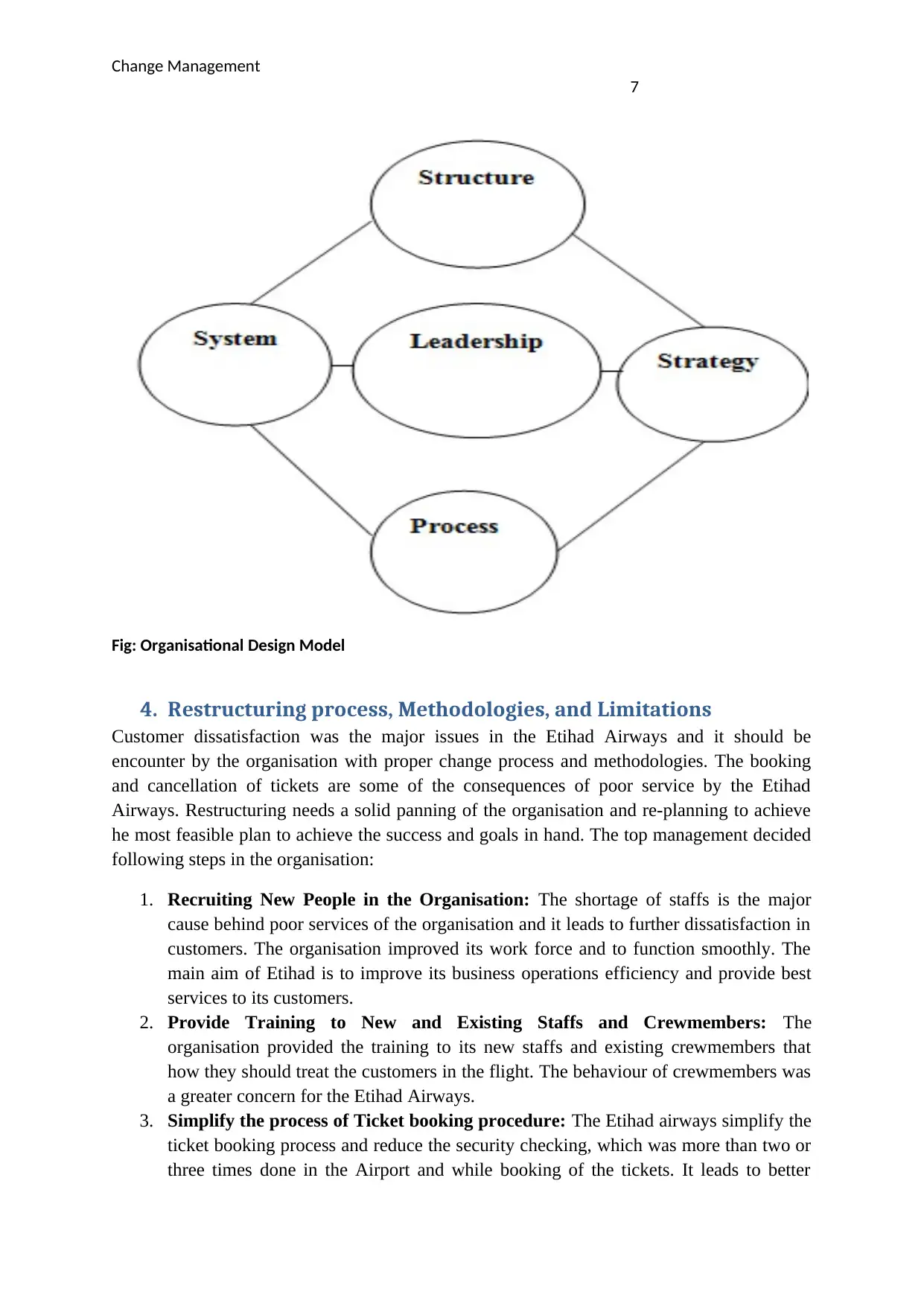
Change Management
7
Fig: Organisational Design Model
4. Restructuring process, Methodologies, and Limitations
Customer dissatisfaction was the major issues in the Etihad Airways and it should be
encounter by the organisation with proper change process and methodologies. The booking
and cancellation of tickets are some of the consequences of poor service by the Etihad
Airways. Restructuring needs a solid panning of the organisation and re-planning to achieve
he most feasible plan to achieve the success and goals in hand. The top management decided
following steps in the organisation:
1. Recruiting New People in the Organisation: The shortage of staffs is the major
cause behind poor services of the organisation and it leads to further dissatisfaction in
customers. The organisation improved its work force and to function smoothly. The
main aim of Etihad is to improve its business operations efficiency and provide best
services to its customers.
2. Provide Training to New and Existing Staffs and Crewmembers: The
organisation provided the training to its new staffs and existing crewmembers that
how they should treat the customers in the flight. The behaviour of crewmembers was
a greater concern for the Etihad Airways.
3. Simplify the process of Ticket booking procedure: The Etihad airways simplify the
ticket booking process and reduce the security checking, which was more than two or
three times done in the Airport and while booking of the tickets. It leads to better
7
Fig: Organisational Design Model
4. Restructuring process, Methodologies, and Limitations
Customer dissatisfaction was the major issues in the Etihad Airways and it should be
encounter by the organisation with proper change process and methodologies. The booking
and cancellation of tickets are some of the consequences of poor service by the Etihad
Airways. Restructuring needs a solid panning of the organisation and re-planning to achieve
he most feasible plan to achieve the success and goals in hand. The top management decided
following steps in the organisation:
1. Recruiting New People in the Organisation: The shortage of staffs is the major
cause behind poor services of the organisation and it leads to further dissatisfaction in
customers. The organisation improved its work force and to function smoothly. The
main aim of Etihad is to improve its business operations efficiency and provide best
services to its customers.
2. Provide Training to New and Existing Staffs and Crewmembers: The
organisation provided the training to its new staffs and existing crewmembers that
how they should treat the customers in the flight. The behaviour of crewmembers was
a greater concern for the Etihad Airways.
3. Simplify the process of Ticket booking procedure: The Etihad airways simplify the
ticket booking process and reduce the security checking, which was more than two or
three times done in the Airport and while booking of the tickets. It leads to better
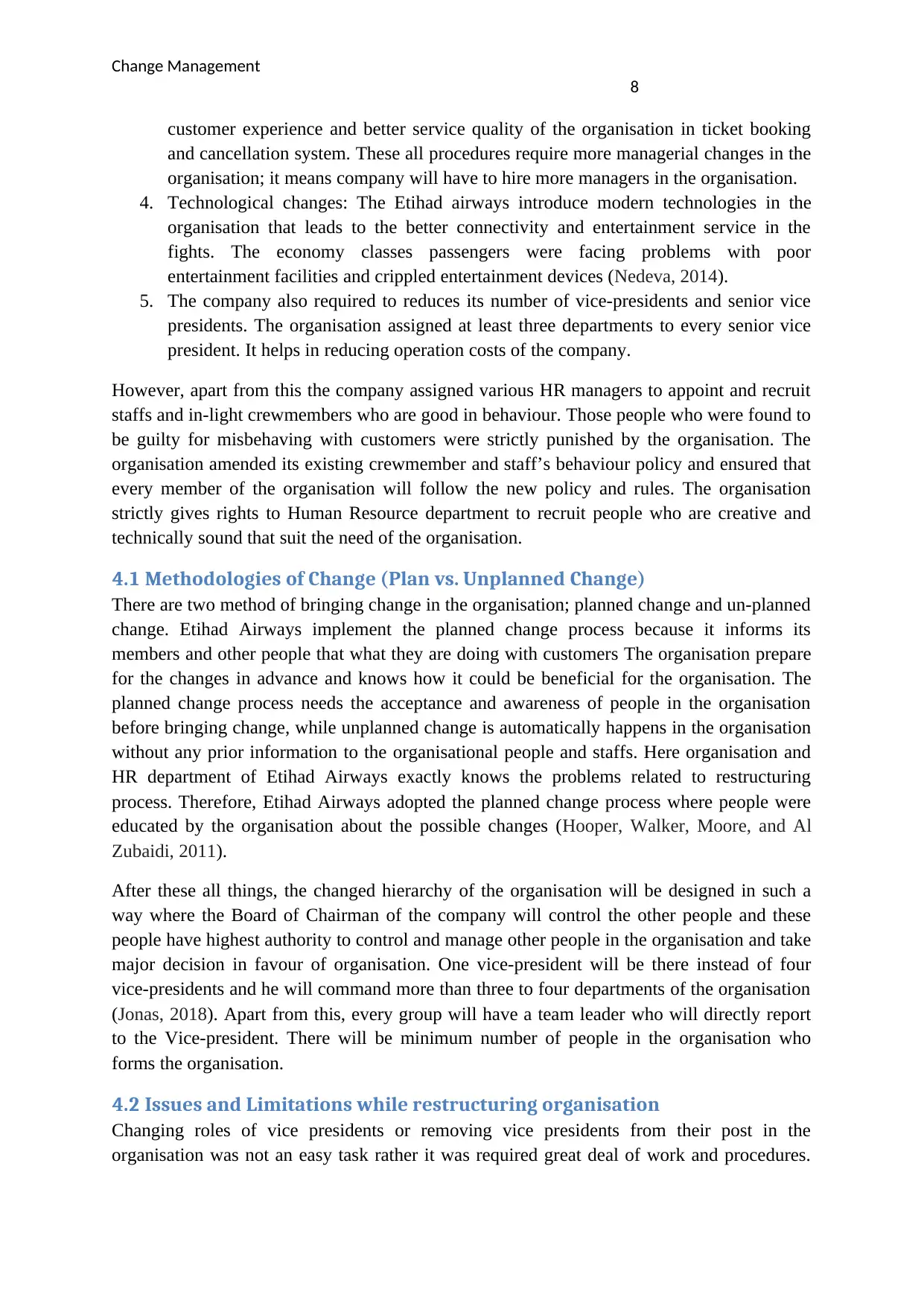
Change Management
8
customer experience and better service quality of the organisation in ticket booking
and cancellation system. These all procedures require more managerial changes in the
organisation; it means company will have to hire more managers in the organisation.
4. Technological changes: The Etihad airways introduce modern technologies in the
organisation that leads to the better connectivity and entertainment service in the
fights. The economy classes passengers were facing problems with poor
entertainment facilities and crippled entertainment devices (Nedeva, 2014).
5. The company also required to reduces its number of vice-presidents and senior vice
presidents. The organisation assigned at least three departments to every senior vice
president. It helps in reducing operation costs of the company.
However, apart from this the company assigned various HR managers to appoint and recruit
staffs and in-light crewmembers who are good in behaviour. Those people who were found to
be guilty for misbehaving with customers were strictly punished by the organisation. The
organisation amended its existing crewmember and staff’s behaviour policy and ensured that
every member of the organisation will follow the new policy and rules. The organisation
strictly gives rights to Human Resource department to recruit people who are creative and
technically sound that suit the need of the organisation.
4.1 Methodologies of Change (Plan vs. Unplanned Change)
There are two method of bringing change in the organisation; planned change and un-planned
change. Etihad Airways implement the planned change process because it informs its
members and other people that what they are doing with customers The organisation prepare
for the changes in advance and knows how it could be beneficial for the organisation. The
planned change process needs the acceptance and awareness of people in the organisation
before bringing change, while unplanned change is automatically happens in the organisation
without any prior information to the organisational people and staffs. Here organisation and
HR department of Etihad Airways exactly knows the problems related to restructuring
process. Therefore, Etihad Airways adopted the planned change process where people were
educated by the organisation about the possible changes (Hooper, Walker, Moore, and Al
Zubaidi, 2011).
After these all things, the changed hierarchy of the organisation will be designed in such a
way where the Board of Chairman of the company will control the other people and these
people have highest authority to control and manage other people in the organisation and take
major decision in favour of organisation. One vice-president will be there instead of four
vice-presidents and he will command more than three to four departments of the organisation
(Jonas, 2018). Apart from this, every group will have a team leader who will directly report
to the Vice-president. There will be minimum number of people in the organisation who
forms the organisation.
4.2 Issues and Limitations while restructuring organisation
Changing roles of vice presidents or removing vice presidents from their post in the
organisation was not an easy task rather it was required great deal of work and procedures.
8
customer experience and better service quality of the organisation in ticket booking
and cancellation system. These all procedures require more managerial changes in the
organisation; it means company will have to hire more managers in the organisation.
4. Technological changes: The Etihad airways introduce modern technologies in the
organisation that leads to the better connectivity and entertainment service in the
fights. The economy classes passengers were facing problems with poor
entertainment facilities and crippled entertainment devices (Nedeva, 2014).
5. The company also required to reduces its number of vice-presidents and senior vice
presidents. The organisation assigned at least three departments to every senior vice
president. It helps in reducing operation costs of the company.
However, apart from this the company assigned various HR managers to appoint and recruit
staffs and in-light crewmembers who are good in behaviour. Those people who were found to
be guilty for misbehaving with customers were strictly punished by the organisation. The
organisation amended its existing crewmember and staff’s behaviour policy and ensured that
every member of the organisation will follow the new policy and rules. The organisation
strictly gives rights to Human Resource department to recruit people who are creative and
technically sound that suit the need of the organisation.
4.1 Methodologies of Change (Plan vs. Unplanned Change)
There are two method of bringing change in the organisation; planned change and un-planned
change. Etihad Airways implement the planned change process because it informs its
members and other people that what they are doing with customers The organisation prepare
for the changes in advance and knows how it could be beneficial for the organisation. The
planned change process needs the acceptance and awareness of people in the organisation
before bringing change, while unplanned change is automatically happens in the organisation
without any prior information to the organisational people and staffs. Here organisation and
HR department of Etihad Airways exactly knows the problems related to restructuring
process. Therefore, Etihad Airways adopted the planned change process where people were
educated by the organisation about the possible changes (Hooper, Walker, Moore, and Al
Zubaidi, 2011).
After these all things, the changed hierarchy of the organisation will be designed in such a
way where the Board of Chairman of the company will control the other people and these
people have highest authority to control and manage other people in the organisation and take
major decision in favour of organisation. One vice-president will be there instead of four
vice-presidents and he will command more than three to four departments of the organisation
(Jonas, 2018). Apart from this, every group will have a team leader who will directly report
to the Vice-president. There will be minimum number of people in the organisation who
forms the organisation.
4.2 Issues and Limitations while restructuring organisation
Changing roles of vice presidents or removing vice presidents from their post in the
organisation was not an easy task rather it was required great deal of work and procedures.
⊘ This is a preview!⊘
Do you want full access?
Subscribe today to unlock all pages.

Trusted by 1+ million students worldwide
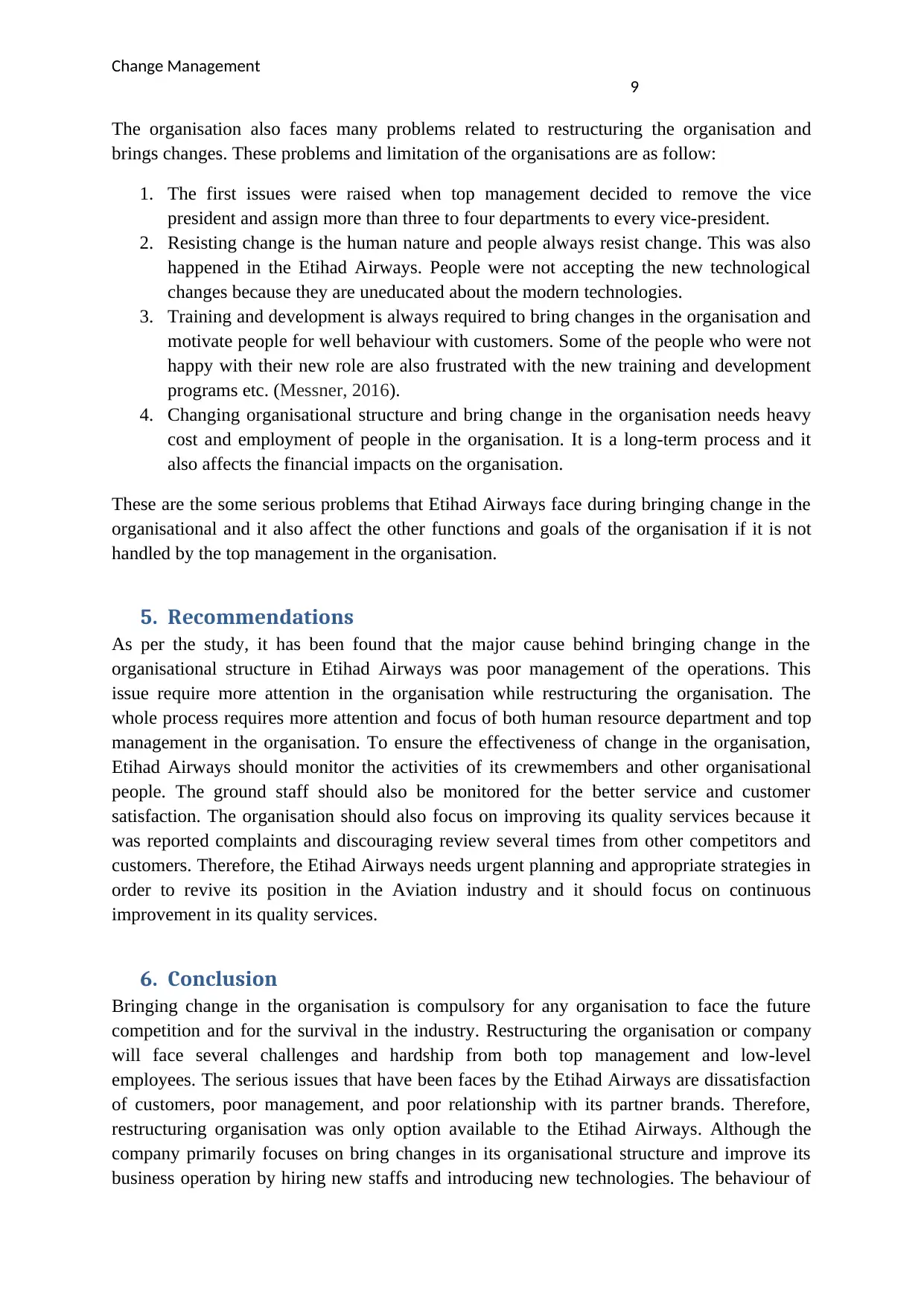
Change Management
9
The organisation also faces many problems related to restructuring the organisation and
brings changes. These problems and limitation of the organisations are as follow:
1. The first issues were raised when top management decided to remove the vice
president and assign more than three to four departments to every vice-president.
2. Resisting change is the human nature and people always resist change. This was also
happened in the Etihad Airways. People were not accepting the new technological
changes because they are uneducated about the modern technologies.
3. Training and development is always required to bring changes in the organisation and
motivate people for well behaviour with customers. Some of the people who were not
happy with their new role are also frustrated with the new training and development
programs etc. (Messner, 2016).
4. Changing organisational structure and bring change in the organisation needs heavy
cost and employment of people in the organisation. It is a long-term process and it
also affects the financial impacts on the organisation.
These are the some serious problems that Etihad Airways face during bringing change in the
organisational and it also affect the other functions and goals of the organisation if it is not
handled by the top management in the organisation.
5. Recommendations
As per the study, it has been found that the major cause behind bringing change in the
organisational structure in Etihad Airways was poor management of the operations. This
issue require more attention in the organisation while restructuring the organisation. The
whole process requires more attention and focus of both human resource department and top
management in the organisation. To ensure the effectiveness of change in the organisation,
Etihad Airways should monitor the activities of its crewmembers and other organisational
people. The ground staff should also be monitored for the better service and customer
satisfaction. The organisation should also focus on improving its quality services because it
was reported complaints and discouraging review several times from other competitors and
customers. Therefore, the Etihad Airways needs urgent planning and appropriate strategies in
order to revive its position in the Aviation industry and it should focus on continuous
improvement in its quality services.
6. Conclusion
Bringing change in the organisation is compulsory for any organisation to face the future
competition and for the survival in the industry. Restructuring the organisation or company
will face several challenges and hardship from both top management and low-level
employees. The serious issues that have been faces by the Etihad Airways are dissatisfaction
of customers, poor management, and poor relationship with its partner brands. Therefore,
restructuring organisation was only option available to the Etihad Airways. Although the
company primarily focuses on bring changes in its organisational structure and improve its
business operation by hiring new staffs and introducing new technologies. The behaviour of
9
The organisation also faces many problems related to restructuring the organisation and
brings changes. These problems and limitation of the organisations are as follow:
1. The first issues were raised when top management decided to remove the vice
president and assign more than three to four departments to every vice-president.
2. Resisting change is the human nature and people always resist change. This was also
happened in the Etihad Airways. People were not accepting the new technological
changes because they are uneducated about the modern technologies.
3. Training and development is always required to bring changes in the organisation and
motivate people for well behaviour with customers. Some of the people who were not
happy with their new role are also frustrated with the new training and development
programs etc. (Messner, 2016).
4. Changing organisational structure and bring change in the organisation needs heavy
cost and employment of people in the organisation. It is a long-term process and it
also affects the financial impacts on the organisation.
These are the some serious problems that Etihad Airways face during bringing change in the
organisational and it also affect the other functions and goals of the organisation if it is not
handled by the top management in the organisation.
5. Recommendations
As per the study, it has been found that the major cause behind bringing change in the
organisational structure in Etihad Airways was poor management of the operations. This
issue require more attention in the organisation while restructuring the organisation. The
whole process requires more attention and focus of both human resource department and top
management in the organisation. To ensure the effectiveness of change in the organisation,
Etihad Airways should monitor the activities of its crewmembers and other organisational
people. The ground staff should also be monitored for the better service and customer
satisfaction. The organisation should also focus on improving its quality services because it
was reported complaints and discouraging review several times from other competitors and
customers. Therefore, the Etihad Airways needs urgent planning and appropriate strategies in
order to revive its position in the Aviation industry and it should focus on continuous
improvement in its quality services.
6. Conclusion
Bringing change in the organisation is compulsory for any organisation to face the future
competition and for the survival in the industry. Restructuring the organisation or company
will face several challenges and hardship from both top management and low-level
employees. The serious issues that have been faces by the Etihad Airways are dissatisfaction
of customers, poor management, and poor relationship with its partner brands. Therefore,
restructuring organisation was only option available to the Etihad Airways. Although the
company primarily focuses on bring changes in its organisational structure and improve its
business operation by hiring new staffs and introducing new technologies. The behaviour of
Paraphrase This Document
Need a fresh take? Get an instant paraphrase of this document with our AI Paraphraser
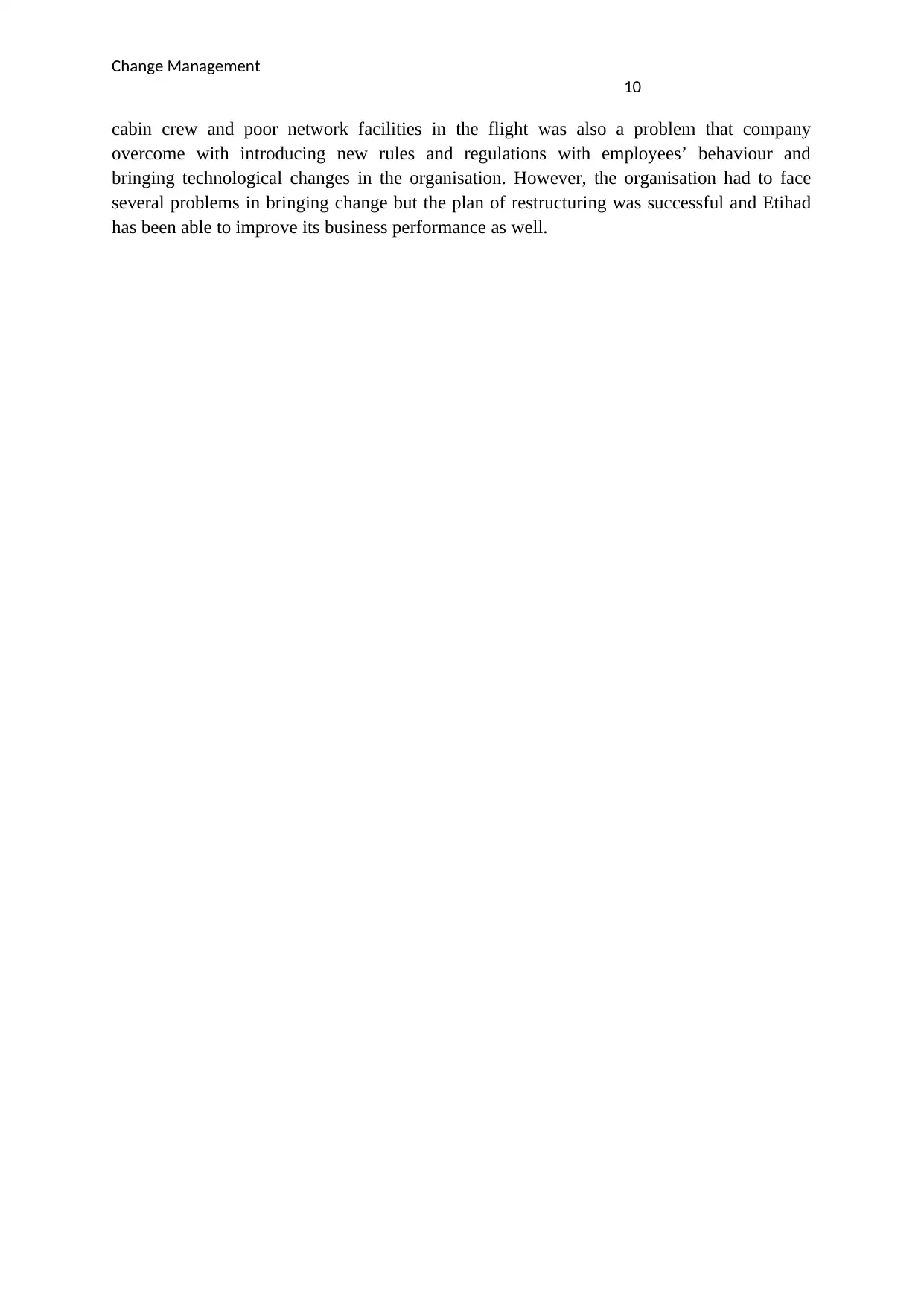
Change Management
10
cabin crew and poor network facilities in the flight was also a problem that company
overcome with introducing new rules and regulations with employees’ behaviour and
bringing technological changes in the organisation. However, the organisation had to face
several problems in bringing change but the plan of restructuring was successful and Etihad
has been able to improve its business performance as well.
10
cabin crew and poor network facilities in the flight was also a problem that company
overcome with introducing new rules and regulations with employees’ behaviour and
bringing technological changes in the organisation. However, the organisation had to face
several problems in bringing change but the plan of restructuring was successful and Etihad
has been able to improve its business performance as well.
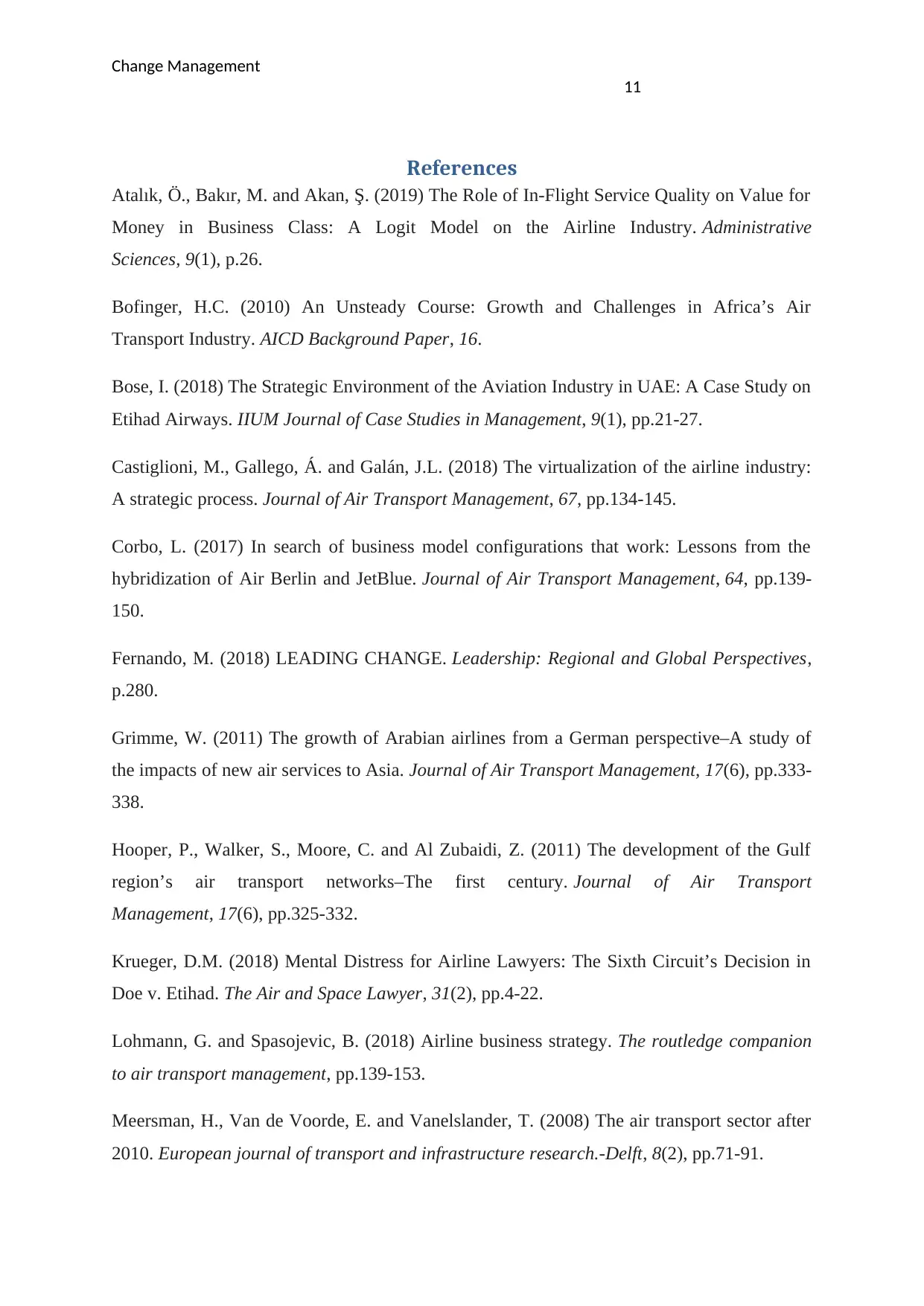
Change Management
11
References
Atalık, Ö., Bakır, M. and Akan, Ş. (2019) The Role of In-Flight Service Quality on Value for
Money in Business Class: A Logit Model on the Airline Industry. Administrative
Sciences, 9(1), p.26.
Bofinger, H.C. (2010) An Unsteady Course: Growth and Challenges in Africa’s Air
Transport Industry. AICD Background Paper, 16.
Bose, I. (2018) The Strategic Environment of the Aviation Industry in UAE: A Case Study on
Etihad Airways. IIUM Journal of Case Studies in Management, 9(1), pp.21-27.
Castiglioni, M., Gallego, Á. and Galán, J.L. (2018) The virtualization of the airline industry:
A strategic process. Journal of Air Transport Management, 67, pp.134-145.
Corbo, L. (2017) In search of business model configurations that work: Lessons from the
hybridization of Air Berlin and JetBlue. Journal of Air Transport Management, 64, pp.139-
150.
Fernando, M. (2018) LEADING CHANGE. Leadership: Regional and Global Perspectives,
p.280.
Grimme, W. (2011) The growth of Arabian airlines from a German perspective–A study of
the impacts of new air services to Asia. Journal of Air Transport Management, 17(6), pp.333-
338.
Hooper, P., Walker, S., Moore, C. and Al Zubaidi, Z. (2011) The development of the Gulf
region’s air transport networks–The first century. Journal of Air Transport
Management, 17(6), pp.325-332.
Krueger, D.M. (2018) Mental Distress for Airline Lawyers: The Sixth Circuit’s Decision in
Doe v. Etihad. The Air and Space Lawyer, 31(2), pp.4-22.
Lohmann, G. and Spasojevic, B. (2018) Airline business strategy. The routledge companion
to air transport management, pp.139-153.
Meersman, H., Van de Voorde, E. and Vanelslander, T. (2008) The air transport sector after
2010. European journal of transport and infrastructure research.-Delft, 8(2), pp.71-91.
11
References
Atalık, Ö., Bakır, M. and Akan, Ş. (2019) The Role of In-Flight Service Quality on Value for
Money in Business Class: A Logit Model on the Airline Industry. Administrative
Sciences, 9(1), p.26.
Bofinger, H.C. (2010) An Unsteady Course: Growth and Challenges in Africa’s Air
Transport Industry. AICD Background Paper, 16.
Bose, I. (2018) The Strategic Environment of the Aviation Industry in UAE: A Case Study on
Etihad Airways. IIUM Journal of Case Studies in Management, 9(1), pp.21-27.
Castiglioni, M., Gallego, Á. and Galán, J.L. (2018) The virtualization of the airline industry:
A strategic process. Journal of Air Transport Management, 67, pp.134-145.
Corbo, L. (2017) In search of business model configurations that work: Lessons from the
hybridization of Air Berlin and JetBlue. Journal of Air Transport Management, 64, pp.139-
150.
Fernando, M. (2018) LEADING CHANGE. Leadership: Regional and Global Perspectives,
p.280.
Grimme, W. (2011) The growth of Arabian airlines from a German perspective–A study of
the impacts of new air services to Asia. Journal of Air Transport Management, 17(6), pp.333-
338.
Hooper, P., Walker, S., Moore, C. and Al Zubaidi, Z. (2011) The development of the Gulf
region’s air transport networks–The first century. Journal of Air Transport
Management, 17(6), pp.325-332.
Krueger, D.M. (2018) Mental Distress for Airline Lawyers: The Sixth Circuit’s Decision in
Doe v. Etihad. The Air and Space Lawyer, 31(2), pp.4-22.
Lohmann, G. and Spasojevic, B. (2018) Airline business strategy. The routledge companion
to air transport management, pp.139-153.
Meersman, H., Van de Voorde, E. and Vanelslander, T. (2008) The air transport sector after
2010. European journal of transport and infrastructure research.-Delft, 8(2), pp.71-91.
⊘ This is a preview!⊘
Do you want full access?
Subscribe today to unlock all pages.

Trusted by 1+ million students worldwide
1 out of 13
Related Documents
Your All-in-One AI-Powered Toolkit for Academic Success.
+13062052269
info@desklib.com
Available 24*7 on WhatsApp / Email
![[object Object]](/_next/static/media/star-bottom.7253800d.svg)
Unlock your academic potential
Copyright © 2020–2025 A2Z Services. All Rights Reserved. Developed and managed by ZUCOL.





